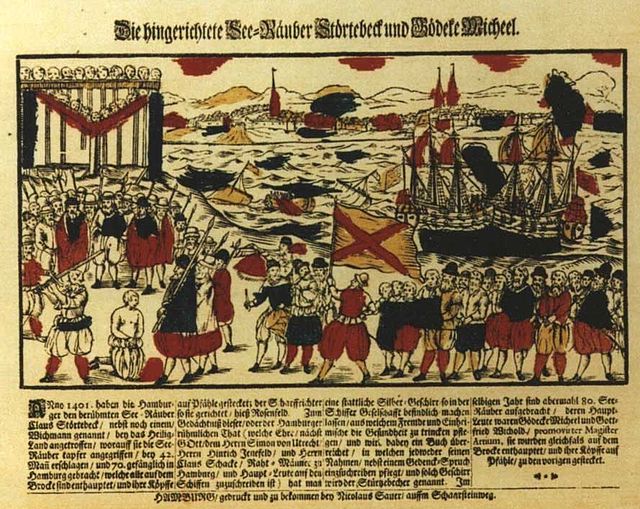"Nikolaus" Storzenbecher or "Klaus" Störtebeker was reputed to be leader of a group of privateers known as the Victual Brothers. The Victual Brothers were originally hired during a war between Denmark and Sweden to fight the Danish and supply the besieged Swedish capital Stockholm with provisions. After the end of the war, the Victual Brothers continued to capture merchant vessels for their own account and named themselves "Likedeelers". Recent studies manifest that Störtebeker was not called "Klaus" but "Johann".
Reconstruction of head from skull ascribed to Störtebeker
Skull ascribed to Störtebeker, found in 1878
Portrait (Etching) of Kunz von der Rosen [de] the court jester of emperor Maximilian I by Daniel Hopfer, which is often erroneously identified as a portrait of Klaus Störtebeker
The summary execution of Störtebeker, 1401; tinted woodcut tby Nicolaus Sauer, Hamburg, 1701 (Hamburger Staatsarchiv)
The Victual Brothers, Vitalien Brothers or Vitalian Brethren were a loosely organized guild of 14th century Germanic privateers. They initially included Mecklenburg nobility, but later became an organisation of commoners, and later evolved into piracy. The guild had a clear historical effect in that era on maritime trade in the North and Baltic Seas. As privateers, they provisioned blockaded locations and otherwise served as a naval contingent on behalf of regional rulers, with clients that included the Queen of Denmark, and rulers of Mecklenburg and East Frisia. As their activities turned to piracy, the aims changed to personal enrichment.
A contemporary representation of the Vitalienbrüder on a wall painting, Bunge church, Gotland, Sweden, c. 1405
The summary execution of Störtebeker, 1401. Tinted woodcut by Nicolaus Sauer, Hamburg, 1701 (Hamburger Staatsarchiv)



![Portrait (Etching) of Kunz von der Rosen [de] the court jester of emperor Maximilian I by Daniel Hopfer, which is often erroneously identified as a po](https://upload.wikimedia.org/wikipedia/commons/thumb/d/d1/Kunz_von_der_Rosen.jpg/455px-Kunz_von_der_Rosen.jpg)

